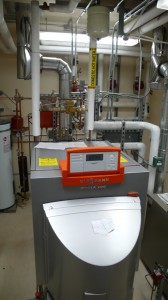 Many homeowners use the same appliance to heat both their house and their domestic hot water. These multipurpose appliances are called combined or integrated systems.
Many homeowners use the same appliance to heat both their house and their domestic hot water. These multipurpose appliances are called combined or integrated systems.
Hot water for space heating goes into a hydronic distribution system or to coils for forced air distribution, while domestic hot water goes to a storage tank or directly to the faucet. Combined systems work with several types of appliances, including boilers, ground source heat pumps or solar thermal systems.
Combined systems offer several advantages over distinct systems. Since an integrated system provides both domestic hot water and space heating, you have fewer appliances to maintain. During the heating season, it’s more efficient to have a single appliance providing both hot water and heating because you have fewer on-off cycles. It also saves space.
On the downside, combined systems can be less efficient when the heating appliance only fires occasionally—in summertime, for example. In addition, it’s tough to measure the efficiency of combined systems because the rating on the appliance (known as the AFUE) only applies to space heating, not domestic hot water. A heating contractor or someone who owns the same appliance can give you a better idea of the actual efficiency.
There are two types of combined systems—storage tank and tankless. Storage tank systems are most popular. In this setup, the appliance simply sees the hot water tank as an additional zone, but one that is separated from the space heating system to avoid contamination of the drinking water. When the domestic hot water tank calls for heat, the appliance sends heat to that zone. Having a storage tank forces the appliance to fire only a few times a day to provide hot water. This design is more efficient than a tankless coil system because the appliance doesn’t have to fire as often, which is an energy-intensive process. Also, since there is no burner on the storage tank you can add extra insulation to the tank to save energy.
A tankless coil system has an extra heat exchanger that fits into the appliance. Water is heated when it flows through the heat exchanger. Tankless coil systems are most efficient when the appliance is already being used for space heating. During summer months, however, the on-off cycling that occurs every time domestic hot water is needed can waste energy. To avoid this, some homes use a tankless coil system during the winter and a separate domestic hot water system during the summer.